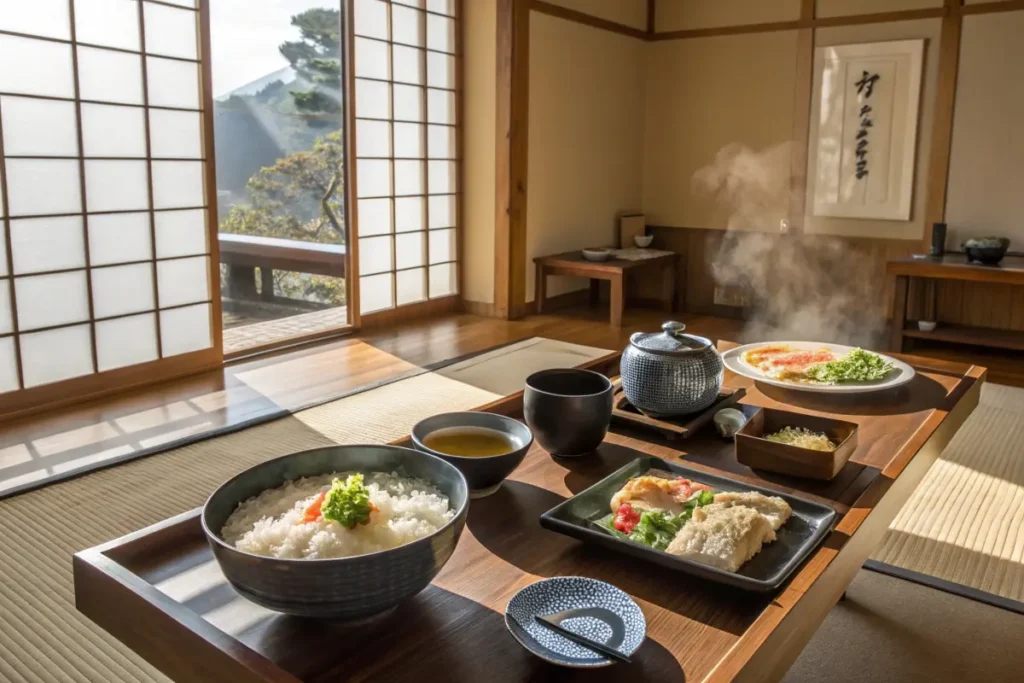For many people worldwide, a morning ritual might revolve around cereal or toast. Yet in Japan, breakfast is treated as a nourishing art form. Within the first moments of tasting japanese breakfast recipes, you’ll discover a world of balanced flavors, nutritious ingredients, and cultural significance. Whether you’re looking to expand your culinary horizons or improve your morning routine, this guide will provide all you need to create an authentic Japanese breakfast experience at home.
If you’re eager to dive deeper into the broader world of Japanese cuisine, be sure to explore our Japanese Vegan Recipes. This resource offers creative ways to adapt traditional dishes for plant-based diets, giving you even more reasons to experiment. Ready to begin your day with flavorful inspiration? Let’s get started!
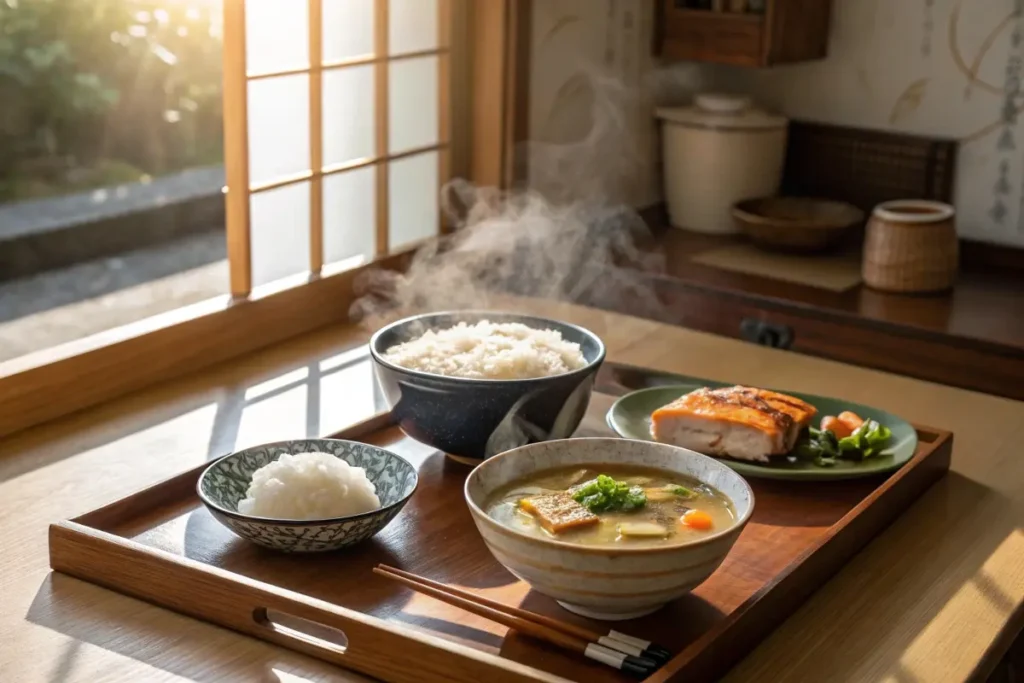
Core Components of Japanese Breakfast
A typical Japanese breakfast emphasizes balance and simplicity. It commonly includes:
- Rice (Gohan):
- The foundation of almost every Japanese meal.
- Steamed short-grain white rice is most common.
- For health-conscious eaters, mixed-grain (like barley) or brown rice can be used.
- Miso Soup (Misoshiru):
- Central to japanese breakfast recipes, typically made from fermented soybean paste (miso).
- Dashi (fish or kombu broth) is combined with miso, tofu, and seasonal vegetables or seaweed.
- Acts as a gentle, warm accompaniment that ties the meal together.
- Protein (Shusai):
- Often fish, with grilled salmon or mackerel being favorites.
- Tamago kake gohan—japanese egg rice—is another popular option. It involves pouring raw egg into hot rice, then mixing in soy sauce or seasonings.
- If raw egg isn’t preferred, tamagoyaki (rolled omelet) or a simple fried egg can be served.
- Side Dishes (Okazu):
- Pickled vegetables (tsukemono) like Japanese radish or cucumbers add a tangy note.
- Fermented foods like natto (fermented soybeans) supply probiotics and a unique flavor.
- Seaweed sheets (nori) and umeboshi (pickled plums) offer extra bursts of savory and sour tastes.
- Tea or Other Beverages:
- Green tea is the classic morning drink, valued for its antioxidants.
- Coffee has also gained popularity in modern Japanese households.
Such a balanced meal provides carbohydrates, proteins, and essential vitamins without being heavy. Each element plays a distinct role in the meal, ensuring a well-rounded, sensory experience. Everything from the seasoning to the table setting is carefully thought through, reflecting the Japanese concept of ichiju-sansai (one soup, three dishes).
Long-Tail Keywords Within This Section
- what do japanese people eat for breakfast
- japanese egg rice breakfast
- japanese breakfast meals
Incorporating these meals into your morning routine might seem challenging at first, but you’ll soon discover how easily they can be adapted. If you want to expand your protein options, consider our Japanese Steak Recipe. While steak is more commonly associated with dinner, the marinades and cooking techniques translate well into a variety of breakfast-friendly dishes.
Health Benefits of a Japanese Breakfast
You might wonder, Why is Japanese breakfast so good? A big reason lies in its nutritional depth and mindful preparation. By combining different food groups, japanese breakfast recipes deliver a variety of essential nutrients, setting you up for a day of sustained energy and focus.
- Balanced Nutrition
- The staple combo of rice, soup, and fish offers proteins, carbohydrates, and healthy fats.
- Vegetables, seaweed, and fermented foods add vitamins, minerals, and probiotics.
- Moderate Caloric Intake
- Portion sizes are generally smaller, encouraging variety over quantity.
- This practice can help you avoid overeating while still feeling satisfied.
- Heart-Healthy Fats
- Fish like salmon and mackerel contain omega-3 fatty acids, beneficial for cardiovascular health.
- Soy-based foods (miso, tofu) also contribute to a balanced fat profile.
- Reduced Sugar and Processed Foods
- Unlike many Western breakfasts, Japanese meals rely on natural flavors from fish, vegetables, and fermented ingredients.
- Sugary cereals and pastries are less common, helping to maintain stable blood sugar levels.
- Focus on Freshness
- Seasonal produce and locally sourced fish ensure a fresh and minimally processed meal.
- This approach not only benefits personal health but also supports local economies and sustainability.
- Mindful Eating
- Small bowls and plates encourage a mindful pace. You’re likely to savor every bite.
- Such mindfulness extends to gratitude, with phrases like “Itadakimasu” before eating.
When you prioritize variety and moderation, you reduce your risk of chronic diseases while maintaining an active, vibrant lifestyle. As you experiment with japanese breakfast recipes, remember that flexibility is key. You can tweak ingredients based on dietary needs or personal preferences—just don’t lose sight of the balance central to Japanese cuisine.
For further inspiration on nutrient-dense sides, be sure to check out our comprehensive guide on Vegetables Japanese Recipe. There, you’ll find a treasure trove of ideas for incorporating more veggies into your breakfast, lunch, or dinner.
Exploring Different Fish Options
One of the most common questions asked is What fish is in Japanese breakfast? Indeed, fish plays a starring role in japanese breakfast recipes, adding both flavor and nutrition to the morning spread. From grilled favorites to smoked options, you have plenty of choices:
- Salmon (Shake)
- Perhaps the most popular fish for breakfast.
- Usually lightly salted or marinated before grilling, yielding a tender, flaky texture.
- Mackerel (Saba)
- Known for its richer, more robust flavor.
- Often grilled or marinated in a sweet and savory sauce.
- Horse Mackerel (Aji)
- Common in coastal areas.
- Can be grilled or served dried (himono style) for a concentrated umami taste.
- Sardines (Iwashi)
- Smaller and more affordable, usually grilled whole.
- High in calcium, especially if you eat the soft bones.
- Smoked Fish
- Options like smoked salmon or smoked mackerel add depth and can be stored longer.
- Pair well with plain rice and miso soup.
How to Prepare and Serve
- Marinating: Consider a simple marinade of soy sauce, mirin, and ginger to infuse flavor. Let the fish soak for 20–30 minutes.
- Grilling Techniques: Use a fish grill or a standard pan. Make sure to pat the fish dry before cooking.
- Serving Suggestions: Serve the fish on a small plate alongside your rice and miso soup. You can add a slice of lemon or grated daikon to enhance the taste.
Pairing Fish with Rice and Eggs
While fish provides protein and healthy fats, you can enhance the meal with additional elements:
- Egg Topping: Many enjoy japanese egg rice (tamago kake gohan) by cracking a raw egg over hot rice. If raw egg doesn’t appeal to you, a soft-boiled or sunny-side-up egg can serve as a tasty alternative.
- Pickled Vegetables: Complement the fish’s savory profile with sweet or sour pickles.
- Fermented Sauces: Top with natto or a drizzle of soy sauce for extra umami.
Safety Considerations
If you’re wary about raw fish or eggs, buy from trusted sources. Opt for sashimi-grade fish if you plan to eat it raw or lightly cooked. For eggs, ensure they’re fresh and preferably pasteurized if you’re pouring them over rice.
When exploring fish varieties, consider our article on Japanese Scallop Recipe for more seafood inspiration. While scallops might be a bit luxurious for an everyday breakfast, their culinary techniques can guide your approach to cooking fish in general.
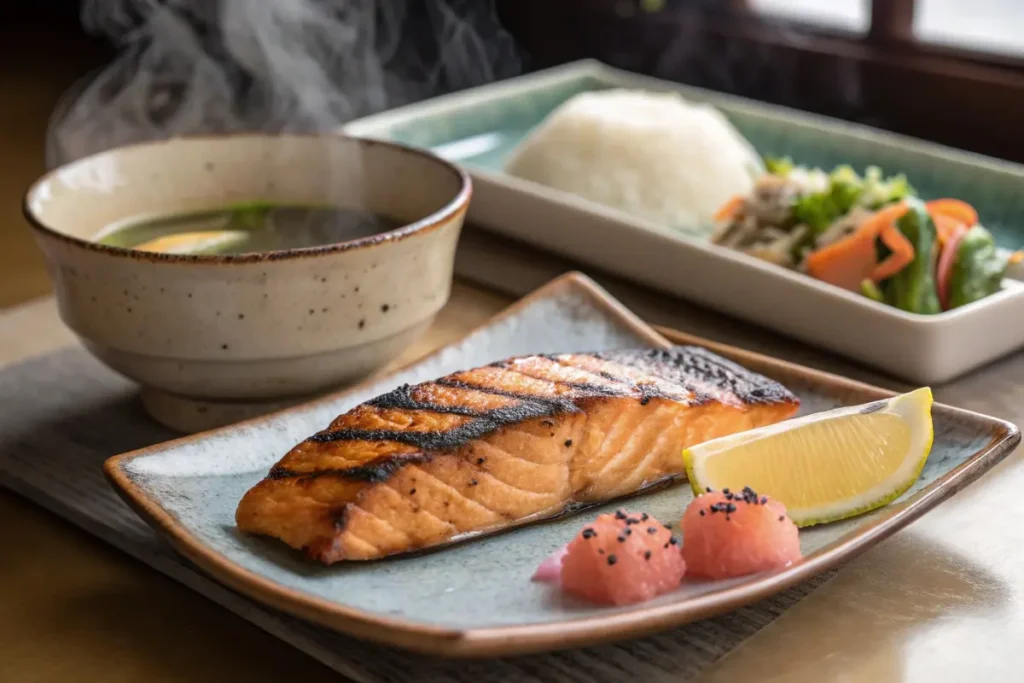
The Role of Eggs in Japanese Breakfast
Eggs are a multi-faceted staple in japanese breakfast recipes. They can appear in various forms, from simple scrambled eggs to elaborate rolled omelets. Understanding these forms helps you explore the depth of egg-based dishes in Japanese cuisine.
- Tamago Kake Gohan (TKG)
- Perhaps the most iconic form of japanese egg rice breakfast.
- Crack a fresh, raw egg into a bowl of hot rice, then add soy sauce or dashi. Mix thoroughly for a creamy texture.
- Traditionally eaten fast, to ensure the egg remains warm.
- Tamagoyaki (Rolled Omelet)
- Made by layering thin sheets of egg seasoned with sugar, soy sauce, and mirin.
- Often slightly sweet and served in neat slices.
- A popular side dish in bento boxes and at breakfast tables.
- Onsen Tamago (Hot Spring Egg)
- Slowly cooked in low-temperature water to achieve a custardy center and a soft but solid white.
- Frequently enjoyed with rice, soy sauce, and scallions.
- Scrambled or Sunny-Side-Up
- Rapidly gaining traction in modern households.
- Served alongside toast or a Western-style breakfast, but can still complement rice and miso soup.
Egg Safety Tips
In Japan, eggs are processed under strict hygiene standards, making raw consumption relatively safe. If you’re outside of Japan:
- Look for pasteurized eggs, especially if you plan on making tamago kake gohan.
- Store eggs in the refrigerator and consume them promptly after purchase.
Beyond Breakfast
While eggs are a morning favorite, you can use similar techniques for lunch or dinner. For instance, tamagoyaki can add variety to your day’s meals. If you want to explore other egg-based or protein-focused dishes, consider reading our guide on Japanese Chicken Fried Rice Recipe for a satisfying one-pan meal that can be adapted for breakfast as well.
Serving Suggestions
- Add Condiments: Top egg dishes with furikake (a dry Japanese seasoning) or thinly sliced green onions for extra flavor.
- Combine Textures: Pair soft eggs with crunchy pickled vegetables to liven up your breakfast.
- Presentation Matters: Small bowls and plates highlight each dish’s colors and textures.
When done right, eggs can elevate your morning meal from ordinary to extraordinary. They seamlessly blend with other flavors, ensuring that a japanese breakfast isn’t just healthy—it’s also rich in taste and variety.
A Complete Japanese Breakfast Meal
Putting together a harmonious Japanese breakfast involves more than just separate dishes. The meal should provide a balanced combination of proteins, carbs, and vegetables, tied together by shared flavors and textures.
- Choose Your Base
- Steamed Rice: Short-grain or mixed-grain rice.
- Egg Rice: If you opt for tamago kake gohan, serve it quickly for best flavor.
- Select a Protein
- Grilled Fish: Salmon, mackerel, or sardines.
- Egg Dishes: TKG, tamagoyaki, or onsen tamago.
- Tofu or Natto: Great for vegetarian or vegan alternatives.
- Add a Soup
- Miso Soup: Classic choice made with dashi, miso, tofu, and seaweed.
- Clear Soup (Sumashijiru): Another option if you prefer a lighter flavor.
- Include Side Dishes
- Pickled Veggies: Tsukemono like pickled radish (takuan) or cucumbers.
- Fermented Foods: Natto, kimchi (Korean influence), or miso-based side dishes.
- Seaweed Sheets: Nori or wakame salad.
- Condiments and Toppings
- Soy Sauce: For seasoning eggs or fish.
- Wasabi or Grated Ginger: Adds a spicy kick.
- Furikake: A mix of dried fish flakes, sesame seeds, and seaweed for flavor and texture.
- Beverage
- Green Tea: Classic for its subtle aroma.
- Coffee: Growing in popularity, especially if you’re aiming for a fusion breakfast.
Meal Planning Tips
- Prep the Night Before:
- Marinate fish or soak kombu for dashi.
- Chop and pickle vegetables in small batches.
- Portion Control:
- Use small bowls for rice and soup to encourage mindful eating.
- Keep side dishes varied but in modest quantities.
- Utilize Leftovers:
- Leftover grilled fish can become the filling in onigiri.
- Miso soup can be reheated with fresh vegetables the next day.
If you’re looking for more expansive ideas, have a look at our Common Japanese Breakfast Foods guide. It showcases various combinations, ensuring you never get stuck in a morning rut.
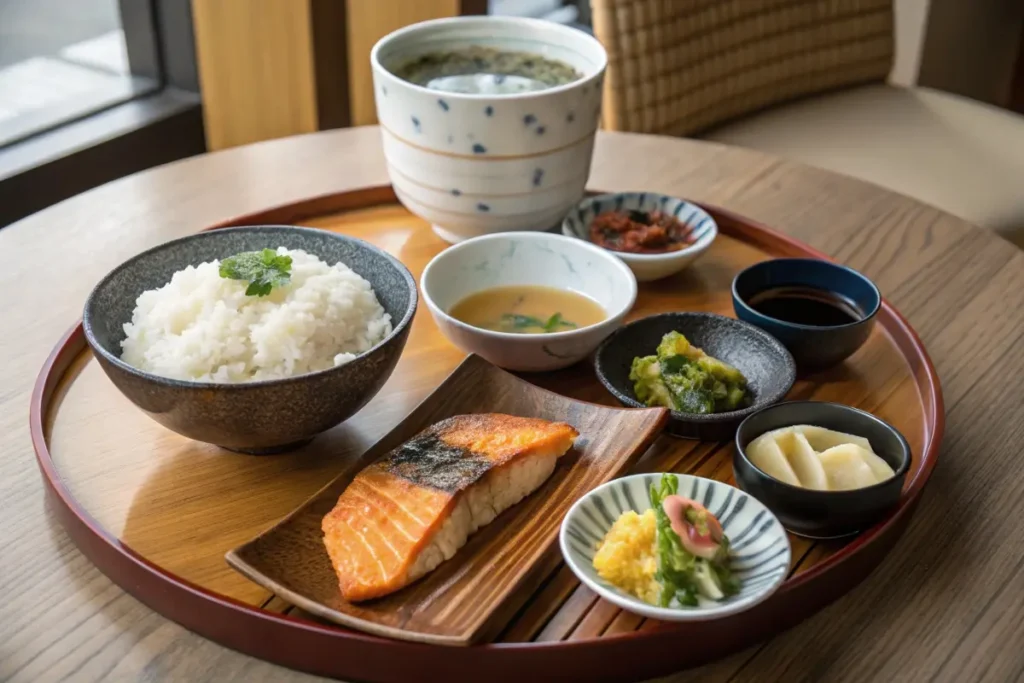
History and Context of Japanese Breakfast
The tradition behind japanese breakfast recipes is a tapestry woven from centuries of cultural, geographical, and religious influences. Rooted in Japan’s agrarian past, the idea of a hearty morning meal became essential for physical labor and maintaining social harmony.
Early Roots
In ancient Japan, breakfast often consisted of rice or millet porridge and pickled vegetables. Protein sources like fish were popular in coastal communities, while inland regions sometimes relied on preserved or dried fish. Seasonality guided ingredient choices, ensuring that meals were fresh and nutritionally diverse.
Influence of Buddhism
During the Heian period (794–1185), Buddhism shaped dietary habits. Monks practiced vegetarian cuisine known as shojin ryori. Although this philosophy emphasized abstaining from animal products, the broader population still consumed fish. Over time, the mindful, balanced approach of Buddhism filtered into mainstream cooking, creating a focus on harmony in meals.
Evolution Through Trade and Modernization
Foreign influence played a role too. The Portuguese introduced tempura in the 16th century, and the Meiji Restoration (1868) brought Western eating habits. While breakfast staples like rice and miso soup remained, bread and coffee gradually appeared on Japanese tables. This fusion birthed modern hybrids, like a Western-Japanese breakfast featuring eggs and toast alongside miso soup.
Post-War Shifts
Economic growth after World War II enabled access to a broader range of foods. Convenience items, such as instant miso soup and onigiri sold in konbini (convenience stores), have since become popular. Despite these modern adaptations, the essence of a Japanese breakfast—balanced, simple, and respectful—remains intact.
Present Day
Currently, Japanese households may serve a strictly traditional breakfast or a mix of global influences. The core idea, however, endures: multiple small dishes, each highlighting the natural flavor of quality ingredients. This heritage aligns well with modern trends toward whole foods, mindful eating, and balanced nutrition.
If you want more context about how Japanese cuisine evolves while retaining its roots, you can browse our page on Traditional Japanese Desserts Recipe to see how age-old customs influence sweet treats. Even at dessert time, the emphasis on simplicity and respect for ingredients rings true, reflecting a culinary ethos deeply entwined with Japanese culture.
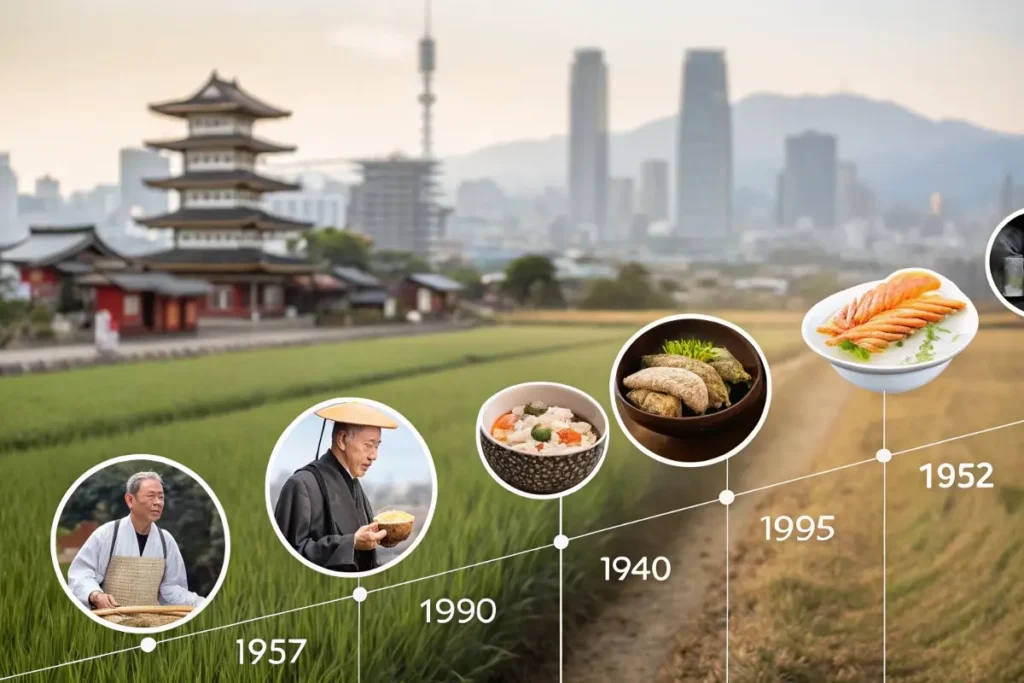
Practical Examples/Use Cases
Incorporating japanese breakfast recipes into your daily routine can feel seamless once you consider different lifestyles and scenarios. Below are some practical use cases that show how you can adapt these meals to fit your schedule and dietary needs.
- Busy Weekday Mornings
- Quick Rice Bowl: Cook rice the night before. In the morning, microwave it and top with a raw egg (or soft-boiled egg if you prefer) and a sprinkle of soy sauce.
- Instant Miso Soup: Keep instant miso soup packets handy. This takes just a minute to prepare, offering a warm, savory boost.
- Why It Works: Minimal prep, yet delivers protein, carbs, and hearty flavor.
- Weekend Brunch
- Grilled Fish and Tamagoyaki: Take your time to marinate salmon or mackerel. Prepare a sweet-and-savory rolled omelet.
- Side of Pickled Veggies: Marinate cucumbers or daikon in vinegar, sugar, and salt overnight.
- Why It Works: Creates a leisurely, restaurant-quality experience at home.
- Family-Style Breakfast
- Interactive Setup: Place bowls of rice, miso soup, grilled fish, and assorted condiments on the table. Let family members serve themselves.
- Include Child-Friendly Options: Scrambled eggs or a mild fish like salmon.
- Why It Works: Encourages everyone to explore different flavors while bonding over a communal meal.
- Health-Conscious Variant
- Brown Rice or Barley-Rice Mix: Swap white rice for a higher fiber alternative.
- Tofu or Natto: Boost protein without adding meat.
- Why It Works: Maintains the balance of a Japanese breakfast but adapts to specific health goals.
- Travel-Friendly Bento
- Onigiri and Hard-Boiled Egg: Wrap a rice ball in nori for easy transport, paired with a boiled egg and pickled side dish.
- Why It Works: Ideal for commuting or enjoying breakfast at work.
These examples illustrate that a Japanese breakfast can be as elaborate or minimal as you need. For more unique ideas, check out our Japanese Breakfast Meals resource. It outlines creative combinations to keep your mornings exciting and fulfilling.
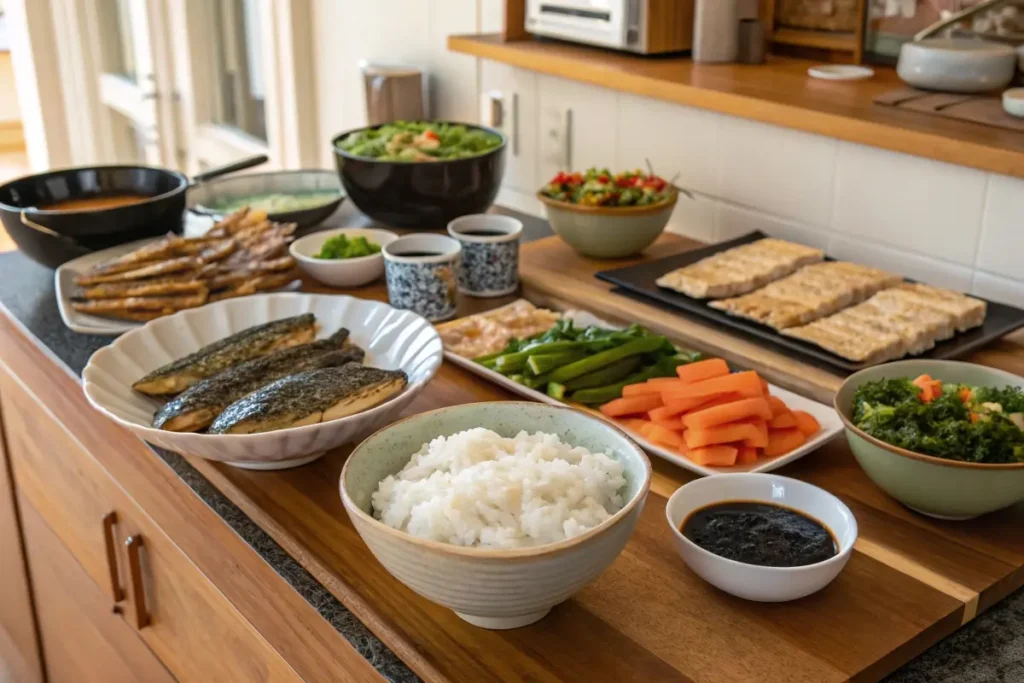
FAQs: Japanese Breakfast Recipes
Below are some frequently asked questions about japanese breakfast recipes, sourced from common Google queries. These concise answers can help demystify typical breakfast practices in Japan.
- What is a typical Japanese breakfast?
A typical Japanese breakfast usually includes steamed rice, miso soup, grilled fish (like salmon), and side dishes like pickled vegetables or seaweed. Eggs—raw or cooked—are also common. The goal is a balanced meal that combines carbohydrates, protein, and various micronutrients. - What is the Japanese breakfast rule?
The term often refers to ichiju-sansai, meaning “one soup, three dishes.” It encourages a balanced meal where rice forms the staple, soup offers comfort, and three side dishes contribute variety in flavor and nutrition. - Why is Japanese breakfast so good?
Many find it flavorful yet balanced. The emphasis on fresh ingredients, portion control, and moderate seasoning ensures a meal that’s both satisfying and health-conscious. Fermented foods like miso and natto provide probiotics, while fish adds omega-3 fatty acids. - What fish is in Japanese breakfast?
Salmon is the most common, but mackerel, horse mackerel, and sardines also appear. Preparation methods range from simple grilling to marinating in soy sauce or mirin. Each type of fish brings a distinct flavor profile. - Is it safe to eat raw egg in Japanese breakfasts?
In Japan, eggs undergo strict quality control, making raw consumption relatively safe. If you’re outside Japan, use pasteurized eggs to lower the risk of foodborne illness. Alternatively, cook your egg partially or fully. - Can I replace fish with another protein?
Absolutely. You can opt for tofu, natto, or even leftover meats like chicken. The key is balance, so pair any protein choice with vegetables, rice, and soup. - Do Japanese people ever eat Western breakfasts?
Yes, especially in urban areas. Many Japanese enjoy toast, cereal, or coffee for a quick fix. Still, many households reserve weekends or special occasions for a more traditional spread.
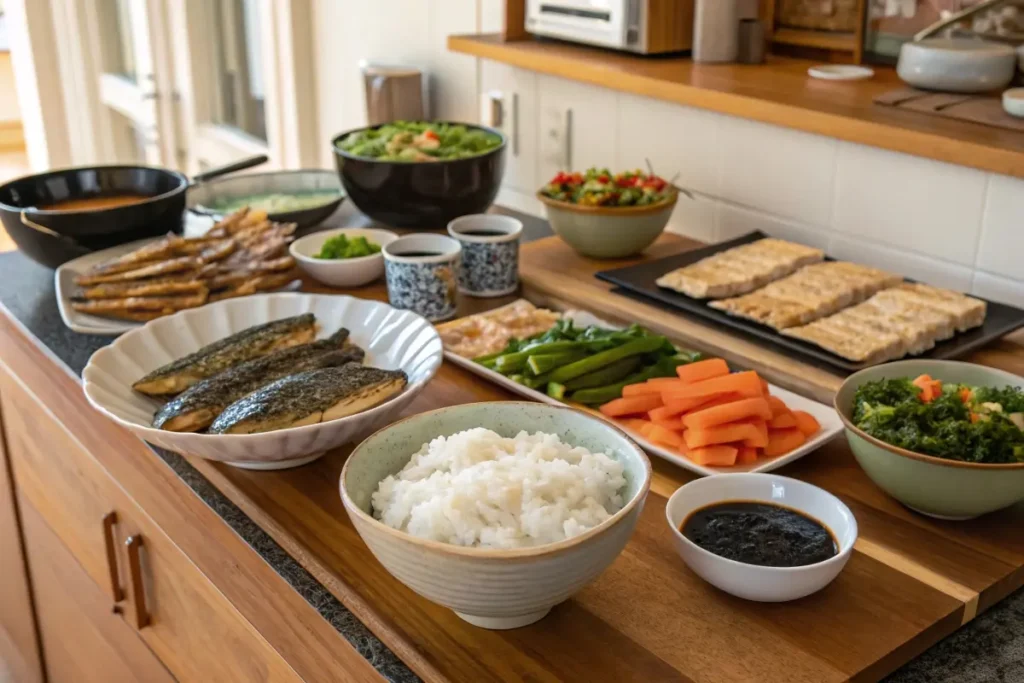
Conclusion
Incorporating japanese breakfast recipes into your daily life can enrich your mornings and expand your culinary toolkit. By focusing on harmony—whether it’s balancing flavors, nutrients, or the mindful presentation of dishes—you’ll discover how these meals nourish both body and soul. From simple combos like rice and miso soup to more elaborate spreads featuring grilled fish, pickles, and egg dishes, there’s a variety of options to suit your taste and schedule.
If you’re new to Japanese cooking, start small. Prep your rice ahead of time or keep instant miso soup on hand. Gradually introduce fermented foods like natto or experiment with tamago kake gohan for an authentic touch. And if you crave even more variety, be sure to Discover Japanese Recipes that extend well beyond breakfast—covering lunches, dinners, and even desserts.
Whether you’re drawn to the health benefits, the comforting flavors, or the cultural richness, making a Japanese-style breakfast is an excellent way to begin your day with intention and satisfaction. Thank you for joining us on this journey through japanese breakfast recipes. May your mornings be more flavorful and fulfilling from here on out!
